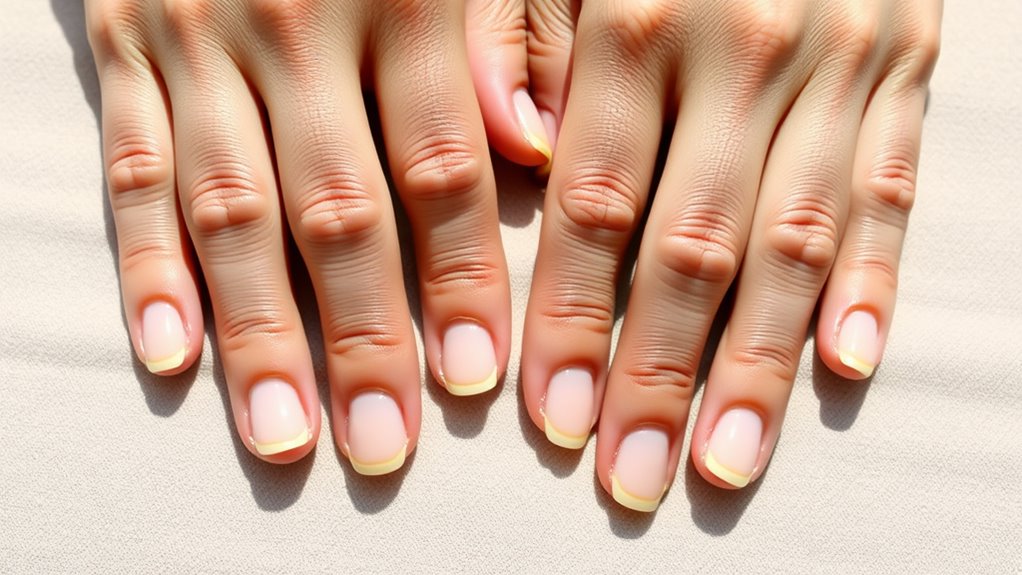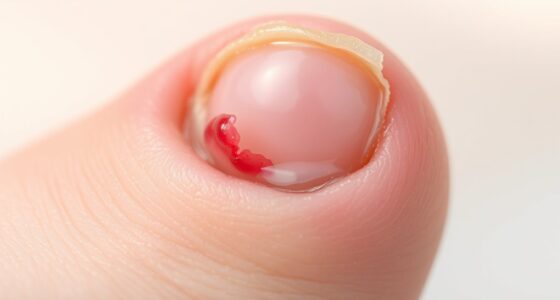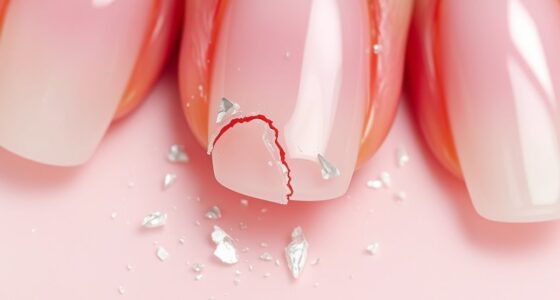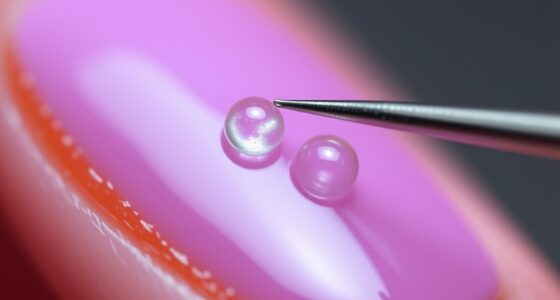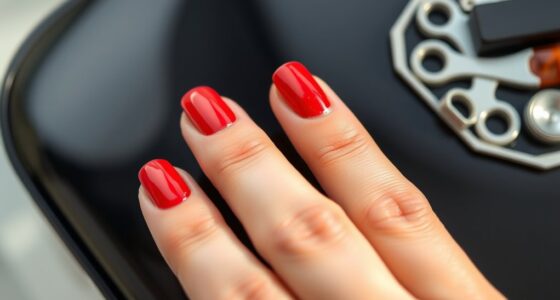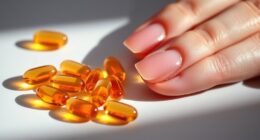To whiten discolored nails, start by using natural remedies like soaking in lemon juice or a baking soda paste, which help break down stains gently. Avoid harsh chemicals and guarantee proper nail hygiene by moisturizing cuticles and giving your nails regular breaks from polish. For stubborn stains, professional treatments like laser therapy can be effective. Keep these tips in mind to restore your nails’ brightness and discover more ways to keep them healthy.
Key Takeaways
- Use natural remedies like lemon juice, baking soda, or hydrogen peroxide to gently bleach and remove stains from nails.
- Regularly moisturize cuticles and avoid harsh chemical removers to prevent further discoloration and maintain nail health.
- Limit dark nail polish use and give nails breaks between manicures to prevent staining buildup.
- For severe or stubborn stains, seek professional treatments such as laser therapy or chemical peels.
- Practice good nail hygiene by cleaning tools, avoiding aggressive polish removal, and wearing gloves during chemical exposure.
Understanding the Causes of Nail Stains
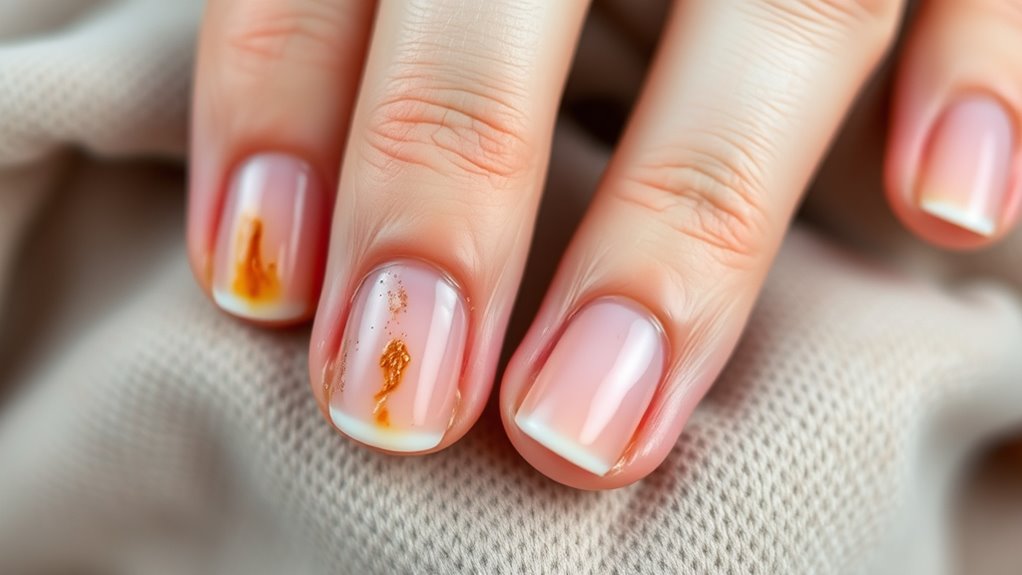
Nail stains often develop because of exposure to certain substances or habits that cause discoloration over time. The main nail stain causes include exposure to pigmented substances like nail polish, smoking, or certain foods, which can leave behind stubborn stains. Discoloration factors such as frequent use of dark-colored nail polish without a base coat, or neglecting proper nail hygiene, also contribute to staining. Additionally, some medications or health conditions may affect nail color, leading to yellow or brownish hues. Understanding these causes helps you identify why your nails are discolored and what habits to adjust. Avoiding prolonged contact with staining agents and maintaining good nail care can considerably reduce the risk of developing stubborn stains. Recognizing these factors is the first step toward restoring your nails’ natural brightness. Regular nail care routines and avoiding harsh chemicals can further protect against discoloration.
Using Lemon Juice for Natural Whitening

Lemon juice is a popular natural remedy for whitening stained nails due to its powerful natural bleaching properties. You can easily use it at home to brighten discolored nails. Simply soak a cotton ball in fresh lemon juice and hold it on your nails for 10-15 minutes. Repeat this process daily for best results. To visualize how lemon juice works, consider this table:
| Step | Action | Result |
|---|---|---|
| Prepare | Squeeze fresh lemon into a bowl | Pure lemon juice |
| Soak | Dip cotton ball in lemon juice | Ready for application |
| Apply | Place on stained nails | Contact with discoloration |
| Wait | Keep for 10-15 minutes | Natural whitening effect |
| Rinse & Repeat | Wash hands and repeat daily | Brighter, whiter nails |
This natural whitening method is simple, effective, and free of harsh chemicals.
Baking Soda as a Gentle Exfoliant
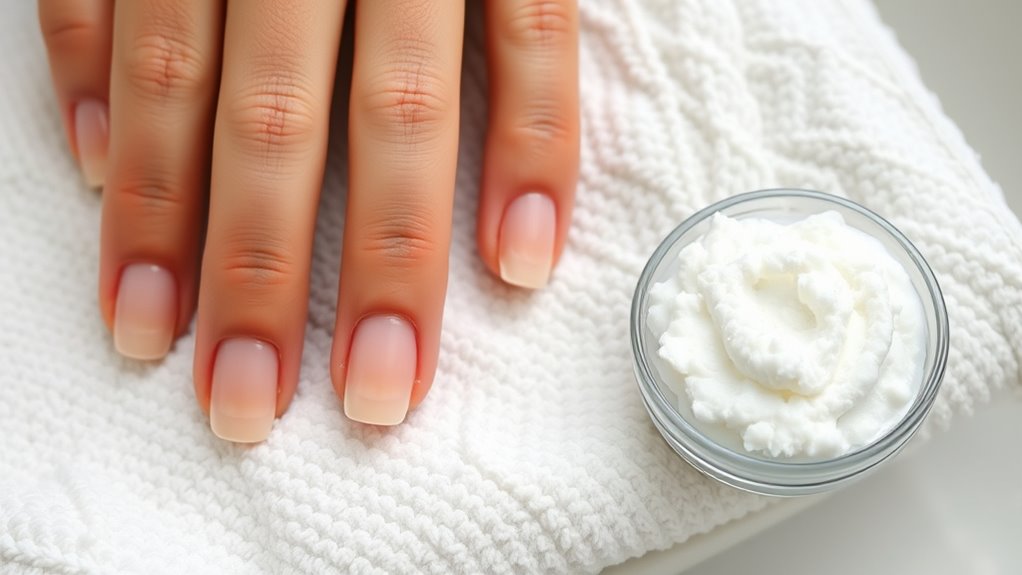
Baking soda is a gentle yet effective exfoliant that can help remove surface stains and smooth your nails. When used correctly, it enhances the appearance of polished nails by gently lifting away dirt and discoloration. Its mild abrasive nature makes it an ideal exfoliation technique without damaging the nail surface. To use, create a paste by mixing baking soda with water, then gently scrub your nails with a soft brush or cloth. This process not only helps whiten discolored nails but also promotes healthy nail growth by removing dead skin cells. Incorporating baking soda into your nail care routine offers a natural way to maintain bright, clean nails while avoiding harsh chemicals. Regular exfoliation with baking soda can make your nails look refreshed and well-maintained. Additionally, understanding data privacy challenges can help you make informed choices about your personal information online.
Hydrogen Peroxide for Effective Stain Removal
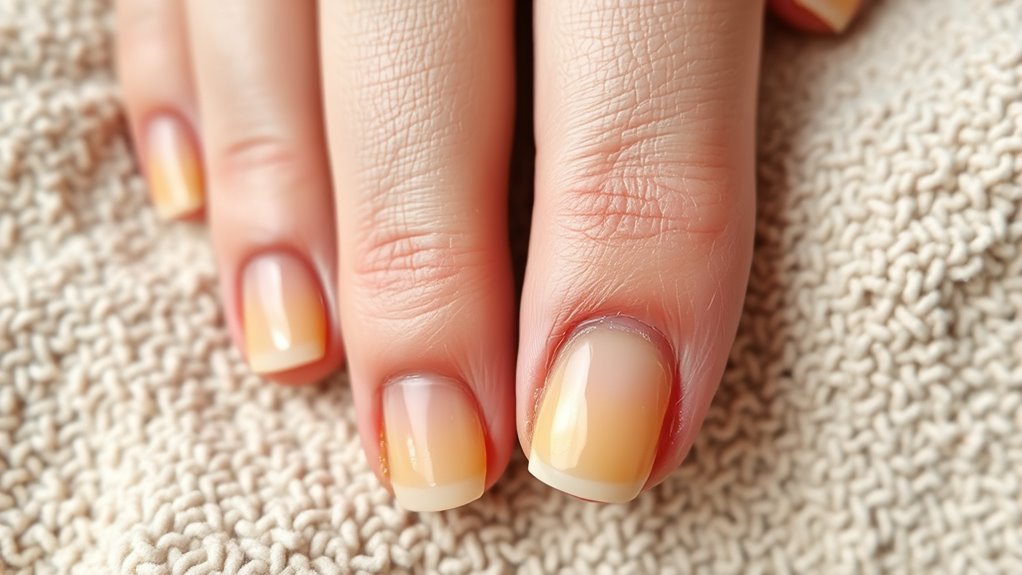
Hydrogen peroxide is a powerful and effective solution for removing stubborn nail stains. It works by breaking down the pigments that cause discoloration, making your nails look brighter. To use it safely, mix equal parts hydrogen peroxide and water, then soak a cotton ball or pad in the solution. Gently apply it to your stained nails, avoiding cuticles and surrounding skin. Unlike nail polish removal, which can sometimes dry out nails, hydrogen peroxide is generally safe when used properly and in moderation. Always remember, hydrogen peroxide safety is key—do not overuse or apply it undiluted, as it can cause irritation. Regular use can help whiten discolored nails, but be cautious and stop if you notice any irritation or sensitivity. Incorporating proper nail care techniques can further improve your nail health and appearance.
Apple Cider Vinegar’s Role in Restoring Nail Color
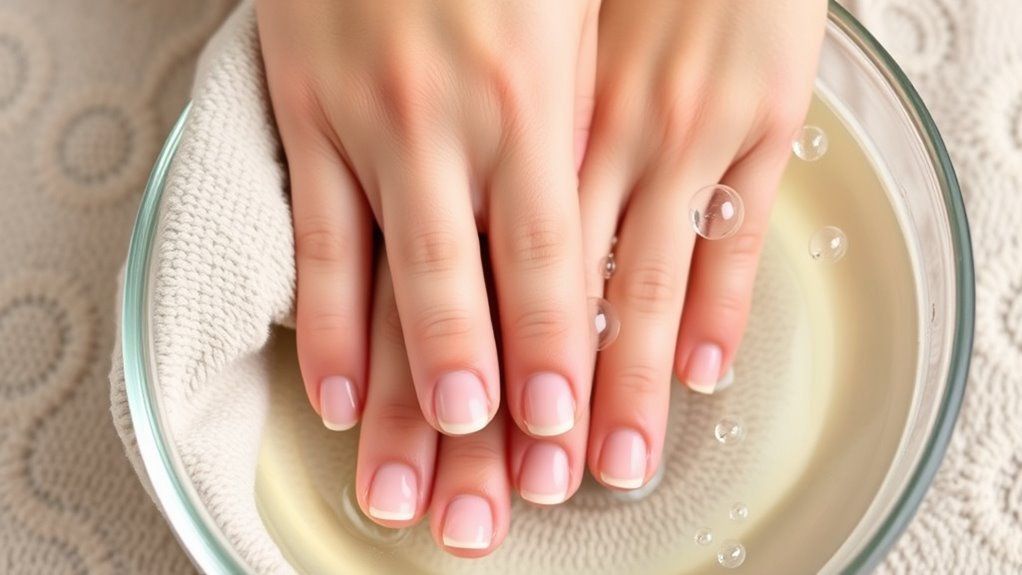
You can use apple cider vinegar as a natural way to restore your nail color. Its antimicrobial properties help keep your nails healthy, while a simple vinegar soak can lighten stains effectively. Just soak your nails in a diluted vinegar solution for a few minutes to see the benefits. Additionally, incorporating natural remedies like vinegar can support overall nail health and complement other whitening techniques.
Natural Stain Removal Method
Apple cider vinegar is a popular natural remedy for removing nail stains because of its acetic acid content, which helps break down discoloration and restore your nails’ natural color. By using this simple solution, you tap into a natural stain removal method that’s gentle yet effective. Regular soaks can brighten your nails and boost your confidence. Imagine seeing your nails regain their healthy glow, free from stubborn stains. Incorporating knowledge of angel number meanings can also inspire a positive mindset during your beauty routine.
| Feeling Confident | Seeing Results | Loving Your Nails |
|---|---|---|
| Bright, clean nails | Noticeable change | Proud display |
| Natural beauty | Fresh, healthy look | Smiling at your hands |
| Effortless care | Stain-free nails | Confidence boost |
Antimicrobial Properties Benefit Nails
Because of its natural antimicrobial properties, apple cider vinegar not only helps remove stains but also fights bacteria and fungi that can cause infections around the nails. These antimicrobial benefits promote healthier nails by reducing the risk of fungal growth and bacterial buildup, which can worsen discoloration and damage. When you use apple cider vinegar regularly, it helps maintain nail health by creating an environment less conducive to harmful microbes. This can prevent infections that might otherwise compromise your nail appearance and overall health. Incorporating apple cider vinegar into your nail care routine supports both stain removal and the preservation of healthy, strong nails. Its antimicrobial properties make it a simple, effective solution for anyone looking to improve nail hygiene and restore natural nail color. Understanding microbiome health plays a key role in maintaining overall nail wellness and preventing recurrent issues.
Simple Vinegar Soaking Technique
A simple soaking method can effectively help restore your nail color and reduce stains. Vinegar benefits, especially from apple cider vinegar, make it a popular choice for nail soak techniques. The acidity in vinegar helps break down stain buildup and brighten discolored nails. To try this, mix equal parts apple cider vinegar and water in a small bowl. Soak your nails for 10-15 minutes, then rinse thoroughly. Repeat this process daily for best results. Vinegar’s natural properties also help prevent future staining and improve overall nail health. This easy and inexpensive method requires no harsh chemicals, making it safe for regular use. Incorporating vinegar into your nail care routine can gradually whiten and restore your nails’ natural color. Using proper headphone compatibility ensures a better experience when listening to music or taking calls while caring for your nails.
Proper Nail Hygiene and Maintenance Tips
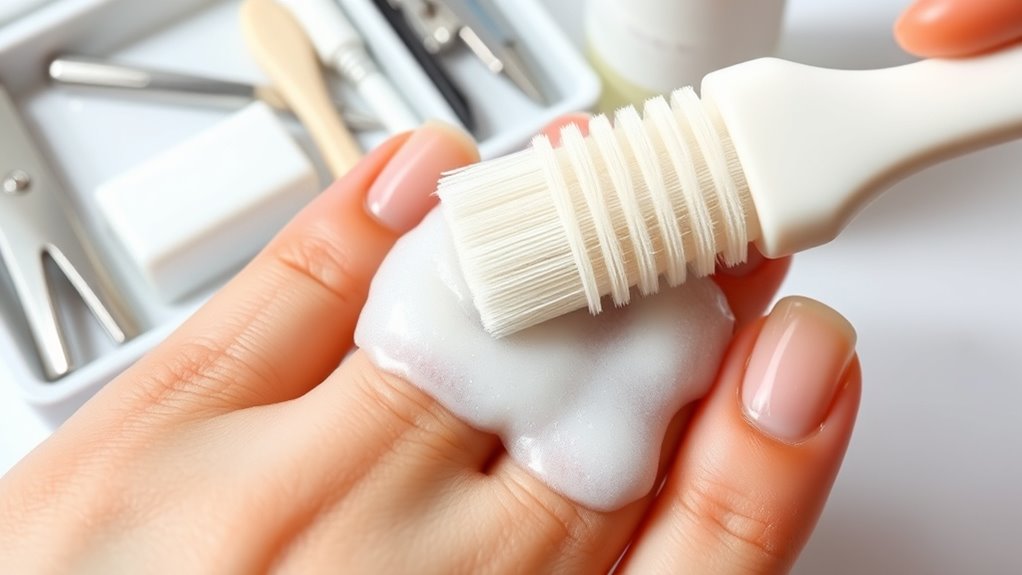
Maintaining proper nail hygiene is essential for preventing stains and keeping your nails healthy. Regular nail trimming helps remove uneven edges and prevents dirt buildup, while gentle cuticle care keeps your nails protected and reduces the risk of infections. To support healthy nails, consider these tips:
- Keep nails short and well-shaped to avoid trapping dirt and bacteria
- Moisturize cuticles regularly to prevent dryness and peeling
- Use clean tools for trimming and cuticle care to prevent contamination
Avoiding Common Habits That Cause Discoloration
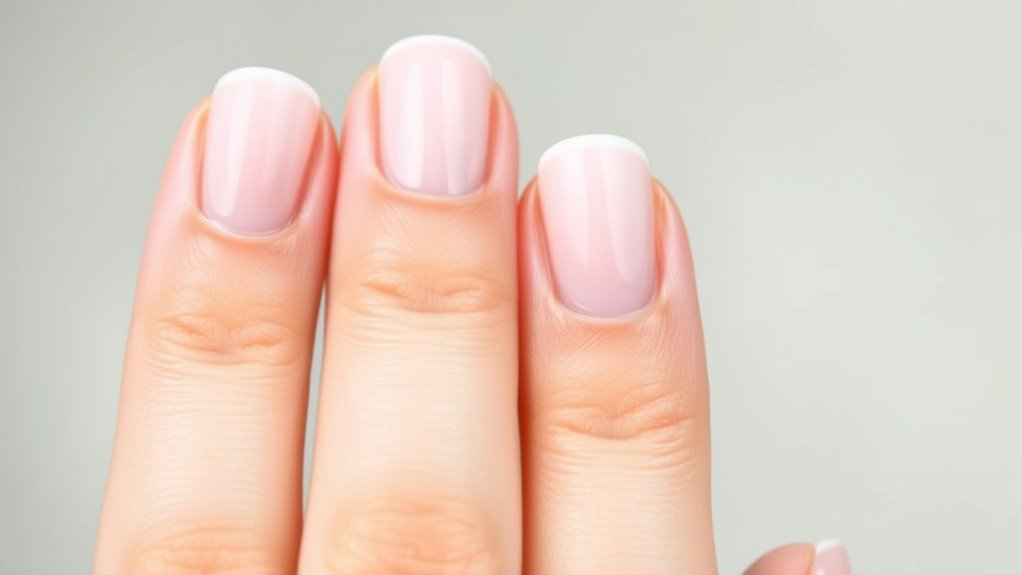
Certain habits can quickly lead to nail discoloration if you’re not careful. One common mistake is improper nail polish removal; using harsh acetone-based removers too often can weaken your nails and cause staining. Instead, opt for gentle, acetone-free polish removers and avoid scraping or peeling polish aggressively. Additionally, neglecting your hand moisturizer routines can dry out your nails and cuticles, making them more prone to discoloration. Regularly applying a nourishing hand moisturizer helps maintain healthy, hydrated nails that resist staining. Limit the frequency of dark nail polish use, and always give your nails a break between manicures. Proper cookie management can also enhance your overall browsing experience, ensuring you access helpful tips and information without interruptions. By avoiding these habits, you reduce the risk of discoloration and keep your nails looking bright and healthy.
Professional Treatments for Severe Stains
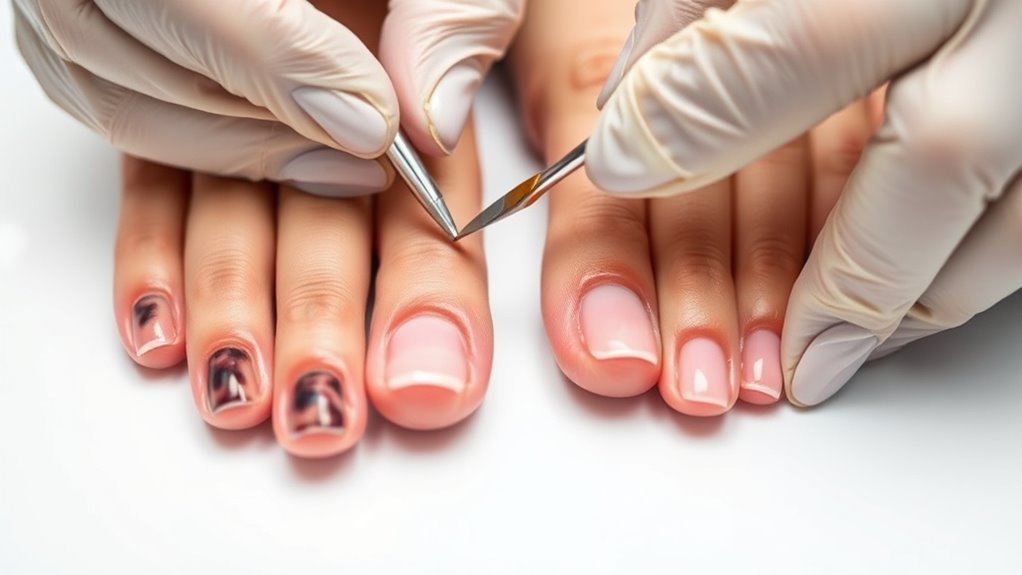
When stains on your nails become deeply ingrained, professional treatments can effectively restore their natural appearance. Laser therapy targets pigment buildup directly, breaking down discoloration for clearer nails. Chemical peels remove the outer layer of stained keratin, revealing fresh, brighter tissue underneath. These treatments are often more effective for severe discoloration than home remedies.
Consider these key points:
- Laser therapy offers quick, targeted results with minimal discomfort
- Chemical peels provide a deep exfoliation for stubborn stains
- Professional assessment ensures the right treatment for your specific case
Preventative Measures to Keep Nails Bright
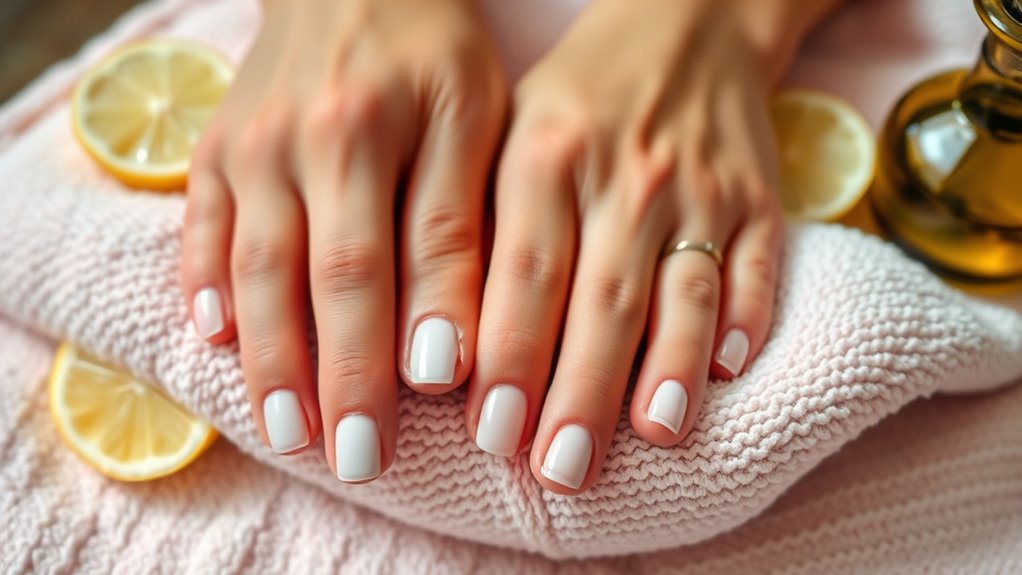
To keep your nails looking bright and prevent deep stains from forming, adopting simple daily habits can make a significant difference. One key step is to be mindful of nail polish removal; opt for acetone-free remover to minimize dryness and damage. After removing polish, use nail hydration techniques like applying cuticle oil or hand cream to keep nails and surrounding skin moisturized. Regularly moisturizing prevents nails from becoming brittle and discolored. Additionally, give your nails breaks from polish whenever possible to allow them to breathe and recover. Wearing gloves during cleaning or exposure to harsh chemicals also helps protect your nails from staining. Ensuring proper filtration systems in your cleaning routine can help reduce airborne dust and allergens that may contribute to nail discoloration. Consistent care, coupled with gentle removal and proper hydration, keeps your nails bright and healthier over time.
Frequently Asked Questions
Are There Any Home Remedies That Could Harm My Nails?
Yes, some home remedies can harm your nails. Using harsh chemicals like bleach or hydrogen peroxide excessively may cause chemical burns or nail damage. Scrubbing with rough tools or using untested natural remedies might weaken or irritate your nails, leading to further discoloration or breakage. Always be cautious, and consider consulting a dermatologist before trying remedies that could potentially harm your nails or skin.
How Long Does It Typically Take to See Results?
Remember, patience is a virtue. Usually, you’ll see results within a week or two when addressing nail stain causes with safe whitening products. Discoloration from nail stains can take longer if caused by deeper issues or harsh treatments. Stick to gentle remedies, follow instructions carefully, and avoid harmful home remedies. Consistency is key—your nails will gradually regain their natural color, proving that slow and steady wins the race.
Can Nail Stains Be a Sign of Health Issues?
Nail discoloration can sometimes signal underlying health issues, so you should take it seriously. If your stained nails persist or worsen, it might indicate conditions like fungal infections, nutritional deficiencies, or other health problems. Pay attention to any additional symptoms and consider consulting a healthcare professional to rule out underlying health concerns. Addressing these issues early can help restore your nail health and overall well-being.
Are There Specific Products Recommended for Sensitive Skin?
Oh, absolutely, because your delicate skin deserves nothing less! For sensitive skin, you should opt for gentle cleansers and hypoallergenic products that won’t cause a fuss. Look for brands labeled “sensitive” or “for delicate skin,” and avoid harsh chemicals. These products help keep your nails and skin healthy without irritation, so you can confidently flaunt your beautifully whitened, stain-free nails without the fear of allergic reactions.
How Often Should I Repeat Whitening Treatments for Best Results?
You should repeat whitening treatments every two to three weeks, following the frequency guidelines to guarantee treatment safety. This interval allows your nails to recover between sessions and minimizes the risk of irritation. Keep an eye on your nails’ response; if you notice sensitivity or damage, extend the time between treatments. Consistent but cautious application helps achieve brighter nails without compromising their health.
Conclusion
By understanding the causes of nail stains and trying these natural remedies, you can restore your nails’ brightness without resorting to a magic wand. Maintain good hygiene, avoid habits that discolor nails, and consider professional treatments if needed. With patience and consistency, your nails will look as radiant as a Victorian lady’s gemstone jewelry. Remember, a little effort today can save you from a future of discolored nails—no need for a fairy godmother, just some TLC!
